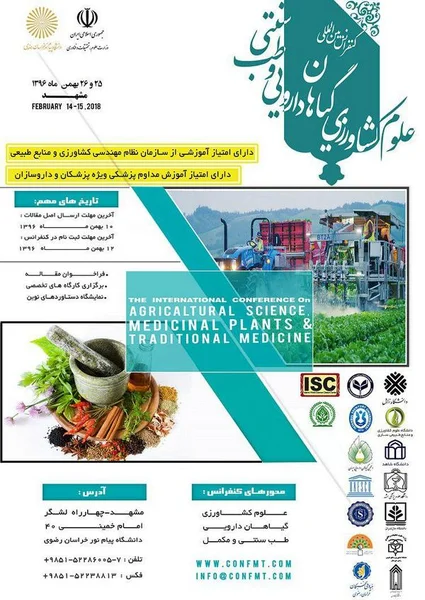-
the effect of humic acid and ascorbic acid on amount and composition of essential oils in dragonhead medicinal plant (dracocephalum moldavica l.) under salinity stress
جزئیات بیشتر مقاله- تاریخ ارائه: 1396/11/19
- تاریخ انتشار در تی پی بین: 1396/11/19
- تعداد بازدید: 347
- تعداد پرسش و پاسخ ها: 0
- شماره تماس دبیرخانه رویداد: -
salinity is one of the most important abiotic stresses that reduces the production ability. in order to improve the performance of plants under salt stress conditions, humic acid as an organic acid and ascorbate as a powerful antioxidant can be effective. a factorial experiment was conducted in a completely randomized design with three replications in order to study the effect of ascorbic acid and humic acid on essential oil amount and components in dragonhead under salinity stress. experimental treatments included salinity at four levels (0, 50, 100 and 150 mm), humic acid and ascorbic acid in three levels (0, 100 and 200 mg/l). plant essential oil was extracted using clevenger apparatus and its components were separated and identified by using gas chromatography and gas chromatography connected to the mass spectrometer. by increasing salinity, the essential oil decreased strongly, and application of mitigations was improved this trait. so that it reached to the lowest level (0.2 percent) in 150 mm salinity stress, and 200 mg/l of humic acid application caused 51.61 percent increase in essential oil compared to the control. geranial, neral, geraniol and geranyl acetate were identified as the main composition at different levels of stress and extenuates. the highest essential oil constituents of dragonhead in control treatment (non-application of extenuating circumstances and without salt) contains geranial, neral, geraniol, geranyl cetate, trans- 4,2- heptadienal, linalool, pulegone and verbenol which included 99.5% of the essential oil components respectively by 36.65, 31.94, 15.56, 11.66, 1.25, 1.09, 0.95 and 0.4 percent. large number combination was observed compared to control treatment and usage of other extenuates (100 and 200 mg/l ascorbic acid and 200 mg/l of humic acid) in different levels of salinity stress with 100 mg/l of humic acid treatment. among these combinations can be noted to alpha-pinene, beta-pinene, camphene, camphor, alpha-thujone, nerol and thymol.
مقالات جدیدترین رویدادها
-
استفاده از تحلیل اهمیت-عملکرد در ارائه الگوی مدیریت خلاقیت سازمانی و ارائه راهکار جهت بهبود
-
بررسی تاثیر ارزش وجوه نقد مازاد بر ساختار سرمایه شرکت های پذیرفته شده در بورس اوراق بهادار تهران
-
بررسی تأثیر سطح افشای ریسک بر قرارداد بدهی شرکت های پذیرفته شده در بورس اوراق بهادار تهران
-
بررسی تأثیر رتبه بندی اعتباری مبتنی بر مدل امتیاز بازار نوظهور بر نقد شوندگی سهام با تأکید بر خصوصی سازی شرکت ها
-
تأثیر آمیخته بازاریابی پوشاک ایرانی بر تصویر ذهنی مشتری پوشاک ایرانی (هاکوپیان)
-
تاثیر ارزش گذاری بیش از واقع بر ارتباط میان استراتژی تجاری و ریزش سهام
-
کاربرد مدل سازی فیزیکی در بررسی نقش حوضه نمکی هرمز در تکوین ساختاری کمربند چین خورده رانده زاگرس
-
بررسی راهکارهای مدیریت پیشگیرانه و مقایسه رویکردهای مختلف از لحاظ کاربرد در مدیریت و نگهداری روسازی
-
نقش سیستم حمل و نقل در مرکز تاریخی شهر استراسبورگ
-
سیستم مدیریت انرژی برای افزایش انعطاف پذیری ریزشبکه ها در طول عملکرد جزیره ای
مقالات جدیدترین ژورنال ها
-
مدیریت و بررسی افسردگی دانش آموزان دختر مقطع متوسطه دوم در دروان کرونا در شهرستان دزفول
-
مدیریت و بررسی خرد سیاسی در اندیشه ی فردوسی در ادب ایران
-
واکاوی و مدیریت توصیفی قلمدان(جاکلیدی)ضریح در موزه آستان قدس رضوی
-
بررسی تاثیر خلاقیت، دانش و انگیزه کارکنان بر پیشنهادات نوآورانه کارکنان ( مورد مطالعه: هتل های 3 و 4 ستاره استان کرمان)
-
بررسی تاثیر کیفیت سیستم های اطلاعاتی بر تصمیم گیری موفق در شرکتهای تولیدی استان اصفهان (مورد مطالعه: مدیران شرکتهای تولیدی استان اصفهان)
-
نقش کاربردی علوم اعصاب در مدیریت ؛ مفاهیم و نظریه ها
-
سیرتکاملی حسابداری با تاکید بر نقش بانک ملی در پایه گذاری حسابداری نوین در ایران
-
اثر بخشی یادگیری الکترونیک در آموزش ریاضی دانش آموزان با تاکید بر یادگیری برنامه نویسی کامپیوتر
-
ارتباط احساسات سرمایه گذاران با بازده تعدیل شده براساس ریسک سهام
-
the relationship between capital structure and business cycle in companies listed on tehran stock exchange




سوال خود را در مورد این مقاله مطرح نمایید :